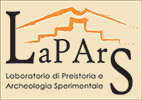Production using hard animal materials
The term "hard animal materials" refers to various parts of the skeletons of both sea and land dwelling animals, (bone, horn, ivory, teeth and shell). While this raw material was widely exploited during the whole of prehistory, studies relating to production in Sardinia are currently few in number. Central to the research conducted by Dr. Laura Manca was the study of these classes of material through the application of a technological procedure. The identifying, decoding, interpretation and creation of a synchronic hierarchy of tool marks were all used to understand the procedures involved. In the light of the data created in this fashion, a par défaut reassembly makes it possible to reconstruct the sequences of transformation, with the purpose of identifying the processes of procurement, the objectives and the methods of transformation. Apart from determining various techno-economic, social and cultural aspects of the community being studied, the results provided by this approach also help to identify and define any possible interactions that exist between the technological procedures used for hard animal materials and those of other types of artefacts.
The study of various Sardinian Neo-Eneolithic industries makes it possible to contribute significantly to the characterisation of techno-complexes, confirming general tendencies and throwing light on the methods of acquisition, transformation and use of these raw materials.
The analysis of bone tool production at the Badas area of Su Coddu (Selargius, Cagliari), relative to the Early Eneolithic, demonstrated the preponderant use of fracturing during the first phase of working. The low level of transformation that the utensils underwent during the assembly phase, realised through abrasion or scraping, illustrates the lack of care invested in the production. This observation seems to be confirmed by the identification of bone splinters employed directly following the débitage phase. The long process of selection effectuated on all the fauna and malacological remains led to the identification of shell artefacts, created through the transformation of oyster valves.
The analysis of pendants and disc-shaped beads recovered from tomb III of the necropolis of S'Elighe Entosu at Usini (Sassari) has made it possible to typify the production of decorative objects in shell relating to the Late Eneolithic - Early Bronze Age. The determination of species and the analysis of the condition of the shell surface has made it possible to identify the method of procurement of the raw material: the majority of valves that were selected and fashioned into ornamental objects, were collected from marine seaboards. The sequence of transformation, concerning each working phase in the case of the disc-shaped beads, but only the shaping in the case of pendants, was recreated through the identification and interpretation of marks and with reference to existing international studies. Lastly, important observations of a social character were formulated following analyses of marks created through usage. This made it very clear that the artefacts had been used over a long period before being buried together with the defunct, thereby excluding the hypothesis of specific production of such objects for funerary rites. At the same time, it was possible to identify the way each object was worn.

